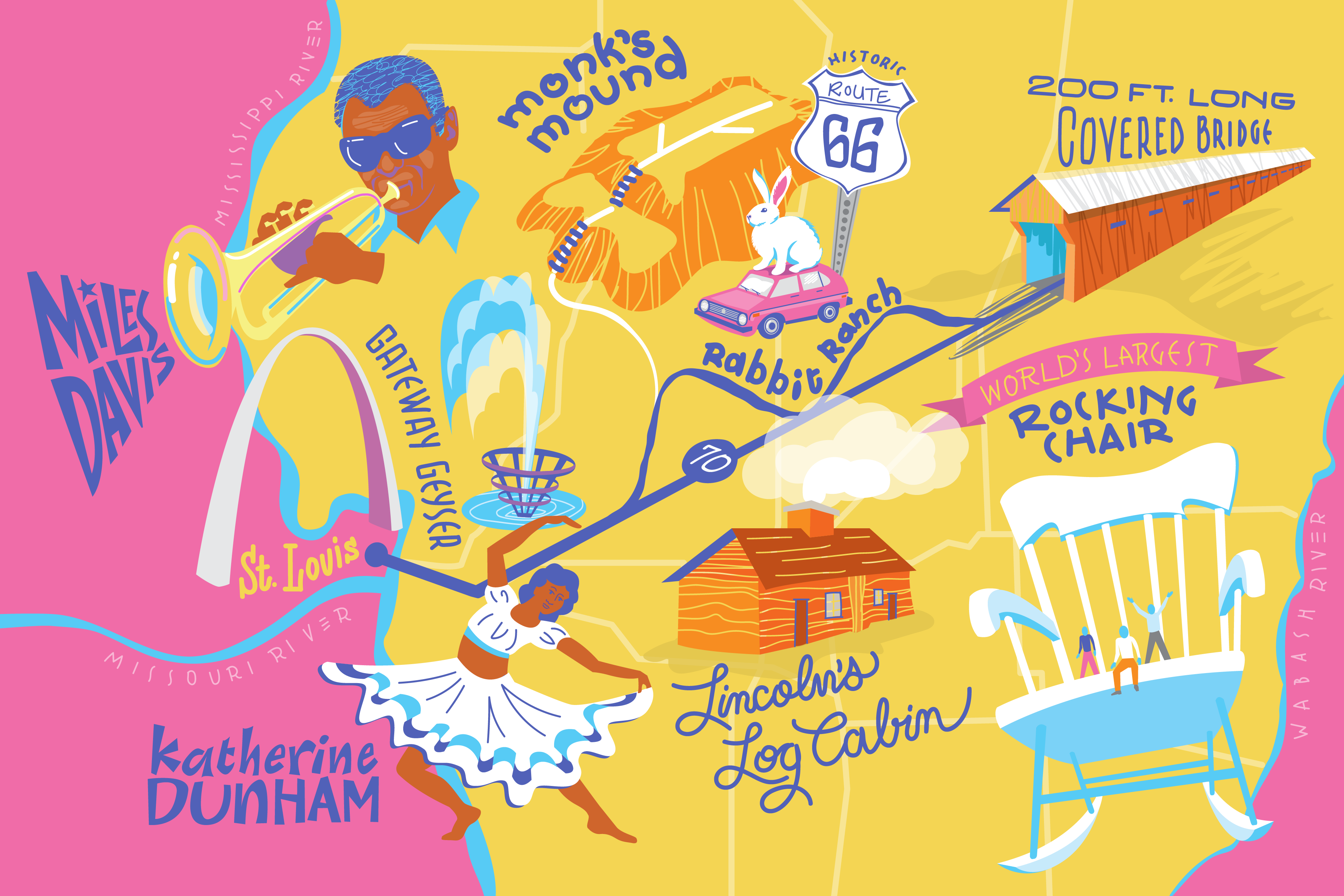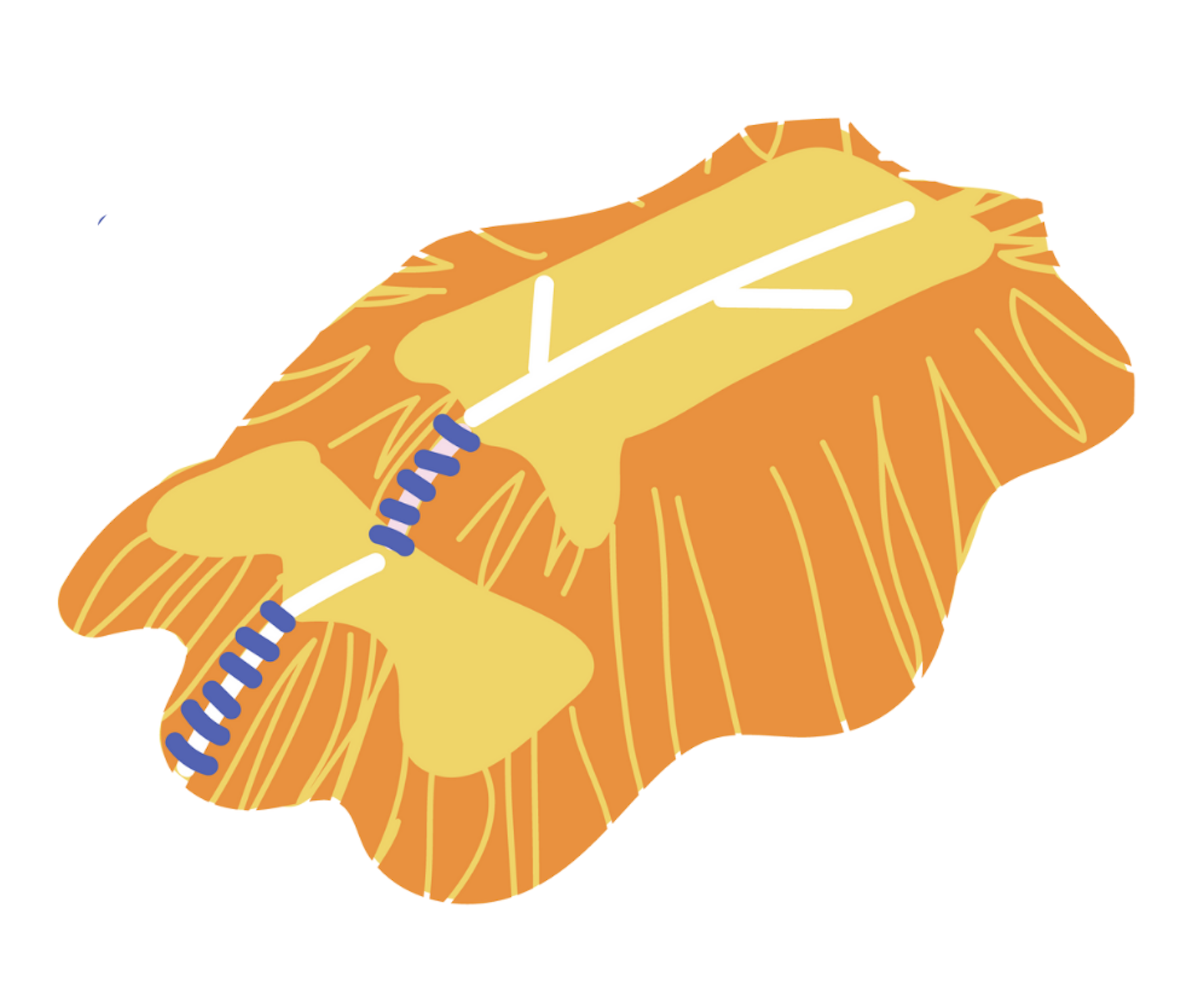
This road trip comes in at just under 200 miles, but packs a punch! This is a part of the U.S. where you’ll find natural beauty and man-made wonders, homes of music and dance legends, and several of the world’s largest objects. This is a place to explore history, indulge a love of the arts, and to get your kicks on Route 66.
Start your journey at the western edge of the state at the Gateway Geyser in East St. Louis. The Gateway Geyser is the tallest water fountain in the U.S., shooting water as high as 630 feet with the St. Louis skyline and famous Gateway Arch as its backdrop.
1) Visit the former homes of a jazz legend and a dance legend in Alton

From here, head to the modest house in nearby Alton, IL, where renowned jazz musician Miles Davis spent his early years. That house at 1701 Kansas Ave, now known as Miles Davis Way, has since been gutted and renovated, and now serves as a community space and is open for tours by appointment.
Miles Davis isn’t the only artistic icon with roots in eastern Illinois; Katherine Dunham, one of the most celebrated Black dancers of the early 20th century, is also from the area.
Dunham’s two-story former home now houses her sprawling collection of African and Caribbean art. The collection of tapestries, paintings, sculpture, and musical instruments spans 50 countries and more than 250 items.
On the top floor of the house, visitors will find posters from Dunham’s dance performances, as well as the paintings she would create as respite after an exhilarating show.
The property hosts community programs throughout the year and an annual intensive workshop on the Dunham Technique, a dance genre created by Dunham and inspired by ballet, modern dance, and dances from the African Diaspora. It also sits on a street that has been renamed to Katherine Dunham Place.
2) Learn about a historic expedition and take in epic views of two mighty rivers
From here, drive north for about an hour and a half to explore a different side of American history at Camp Dubois, near present-day Hartford. From 1804 to 1805, Camp Dubois hosted explorers headed to the western United States as part of the Lewis & Clark Expedition.
The site tells the story of that historic expedition through a 14,000-square-foot museum, a reconstructed settlers’ cabin and a reconstructed campsite. The site hosts occasional historic reenactments, so don’t be surprised if you look around and feel like you’ve stepped back in time.
For a bird’s eye view of this terrain and the spot where the mighty Mississippi and Missouri rivers meet, stop at the nearby Lewis & Clark Confluence Tower. The tower provides sweeping views of the two longest rivers in North America from up to 150 feet above ground.
The tower has three observation decks, each accessible by stairs and elevator. Exhibits about Lewis & Clark and the importance of this region on their journey are incorporated into each level, and on a clear day, visitors can even see as far as the Gateway Arch in St. Louis from the top observation deck.
3) Explore the ancient civilization of Cahokia in Collinsville

From here, make your way toward the Cahokia Mounds State Historic Site in Collinsville to head even further back into the history of this area. This site contains the remnants of an ancient settlement known today as Cahokia; this 2,200 parcel of land housed what is believed to have been one of the most sophisticated prehistoric native civilizations north of Mexico.
Less than half of the site—about 800 acres—is currently open to visitors. An interpretive center includes a model of the site and recreates a portion of the village, and several trails criss-cross the park, leading to key points like Monks Mound.
Monks Mound is an estimated 100 feet high, 955 feet long, and 755 feet wide. Made of soil and clay, the platform mound is the largest known pre-Columbian earthwork in the Americas.
Camping is available at the Cahokia Mounds State Historic Site, though hotels also are available nearby.
4) Get your kicks on Route 66
The next part of this road trip is where the landscape transitions to 20th century Americana. This stretch is one of the picture-perfect scenes seemingly out of historic postcards and full of quirky sites you won’t find anywhere else.
From Cahokia Mounds, head north towards Route 66 and stop in at Henry’s Rabbit Ranch outside of Staunton. This odd roadside attraction is part actual rabbit ranch and part homage to icons of a bygone era, like VW rabbits and old gas pumps.
This site is a replica gas station that was created for visitors. For a real historic Route 66 gas station, keep driving north to the city of Mount Olive.
In Mount Olive, you’ll find the Soulsby Service Station, which fueled up cars from 1926 through the Great Depression and until 1991. It closed in 1993 and has since been restored to look exactly like it did in its heyday just after World War II.
While you can’t get gas at the Soulsby Service Station anymore, you’ll definitely want to stop for a photo.
5) Pay your respects to Mother Jones and check out the original Route 66 sign

From here, make the five-minute drive to the Mother Jones Monument and Burial Site, an homage to the labor rights legend.
Several years before her death in 1930, labor rights activist Mary Harris Jones, known as Mother Jones, decided she would be buried in Mt. Olive at the Union Miners Cemetery, the only U.S. cemetery owned by a union. And she was.
Nowadays, the site serves not just as a shrine to Jones but to the broader movement for greater labor rights. The monument itself is 22-feet high and made from 80 tons of Minnesota pink granite, and is flanked by two bronze statues of miners.
From here, make a quick stop in Litchfield to check out the Litchfield Museum and Route 66 Welcome Center.
The museum is home to the original Route 66 road sign, a well-preserved antique automobile, and several historic maps and drawings. There’s also a 1904 time capsule from the American Radiator Company.
Once you’ve gotten your history fix (maybe a snack!), prepare to be wowed by nature.
6) Take a break for boating, hiking, biking, or horseback riding
Stop at the Shoal Creek Conservation Area to explore 266 acres of towering Oak and Hickory trees. This natural preserve is home to an estimated 700 plant species, 70 butterfly species, and more than 70 types of birds. Hiking trails range from easy to moderate in difficulty. Best of all, admission and parking are free.
At the edge of Shoal Creek, you’ll find Lake Lou Yaeger, a 1,357-acre human-made reservoir that’s popular among boaters and fishers in search of crappie, bass, catfish, and bluegill. During the summer, a sandy beach is open for sunbathing, and trails for biking and horseback riding are nearby.
7) Check out the giant fire-breathing dragon in Vandalia
After getting your nature fix, head east toward Vandalia and prepare to indulge your inner photographer. The final stretch of this road trip is larger than life—literally. From mailboxes to teeter totters, and even a dragon, it is teeming with giants.
In Vandalia, you’ll find the Kaskaskia Dragon, a giant dragon which spews actual fire for about 10 seconds at a time for a dollar a pop. The dragon was created for a Halloween parade, but in the past few years it’s become a truly one-of-a-kind roadside destination.
The towering silver dragon has a 16-foot neck, built-in hydraulic system, and the capacity to spew actual fire. Visitors insert specially designed dragon coins to set off flames from a 20-pound propane tank inside the dragon.
8) Explore a gorgeous historic mansion in Altamont
From here, keep heading east toward the Dr. Charles Wright House in Altamont, IL. The gorgeous brick house was built in 1889 for the family of one of the area’s only doctors.
The 6,000-square-foot home has seven bedrooms and one bathroom and, at the time, cost about $35,000 to build (though this would be equal to over $1 million today!). It was the first grand house in the area to have gas lights, indoor plumbing, and a central steam-heating system.
The house had been occupied by the Wright family for three generations, but nowadays, it’s operated by a non-profit trust and hosts public tours. Much of the original furniture remains in place, and the interior looks largely like it did in 1889.
9) Walk through the longest covered bridge in the state in Greenup

After wandering that historic home, hop in the car and head east on I-70 to check out the Cumberland County Covered Bridge. The 200-foot-long bridge is the longest covered bridge in Illinois and crosses the Embarras River in tiny Greenup.
This bridge is a reconstructed version of the original, built on the site in 1832. That bridge was washed out in 1865, and its replacement was yet again wiped out in 1912.
The current bridge was built in 2000, and it looks like it may be built to last. You’ll want to get out of the car and take a stroll through to check out the gorgeous trusses that support the structure.
10) Delve into presidential history at the Lincoln Log Cabin

After a walk through the bridge, prepare to dive into presidential history with a visit to the Lincoln Log Cabin State Historic Site. The centerpiece of the 86-acre park is a replica of a log cabin that was once home to Thomas Lincoln, the father of U.S. President Abraham Lincoln.
By the time the senior Lincoln moved in, Abraham Lincoln had already moved out of the house. The two-room saddlebag-style log cabin had two main rooms, as well as a loft space accessible by ladder. At times, up to 18 family members lived at the cabin.
Like the Cumberland County Covered Bridge, this log cabin isn’t an original. The original cabin was exhibited at the World’s Columbian Exposition in Chicago in 1893 and then lost, with some people believing its pieces became firewood.
The site is built around a replica cabin and two other historic homes, one of which hosted Abraham Lincoln’s last meeting with his stepmother Sarah Bush Lincoln. The property also is home to sprawling cornfields, comfortable gardens, small orchards, livestock, and even outbuildings like those that would be found on an Illinois farm in the 1840s.
11) Go big in tiny Casey

From here, head to Casey, IL, a small town that marks the midway point between St. Louis, MO, and Indianapolis, IN. Though small itself, this tiny, one-stoplight town is filled with towering versions of all sorts of things.
Casey is home to 12 objects certified to be the world’s largest by the Guinness Book of World Records. There’s a giant mailbox, a giant rocking chair, a giant golf driver, and even an outsized pitchfork.
Prefer to create an optical illusion by posing with a giant car key? You can do that in Casey, too. Or show off your new haircut in front of the world’s largest barber pole. Traveling with a friend? Jump on the jumbo teeter totter and feel like kids again!
And while they may not officially be the world’s largest, Casey is also home to more than a dozen other big things, including a pair of giant antlers, a huge softball bat, and an oversized birdcage. In case that isn’t enough, there’s also a huge mouse trap, a supersized rocking horse, and even a giant pizza slicer.
If you’re among the people who have taken up knitting during the pandemic, you’ll want to head to The Yarn Studio to check out the pair of knitting needles that used to be the world’s largest. These needles are 13.75 feet long and 3.25 inches in diameter, and each weighs about 25 pounds. The store is also home to a giant crochet hook that was another previous world record holder.
Casey’s quest to become the home of big things started with a local business owner who began creating the giant objects, but its big ambitions go beyond town limits.
Keep going
Head east to Marshall and you’ll find the World’s Largest Gavel, according to the Guinness Book of World Records.
That gavel is more than 16 feet long and five feet tall and sits outside the Clark County Courthouse, where Abraham Lincoln could have been found practicing the law around 1850.
Lincoln began his political career in Illinois and lived in the state when he became the 16th president of the United States in 1861.
To dive deeper into Lincoln’s Illinois roots and see a few more giant things, keep your Illinois road trip going. Head to Springfield to see the Lincoln Presidential Library, the Lincoln Home National Historic Site, and even the tomb that is Lincoln’s final resting place. And if that isn’t enough, head to Lincoln, IL, where you’ll find the world’s largest covered wagon carrying a giant Abe Lincoln and an onramp back onto Route 66.